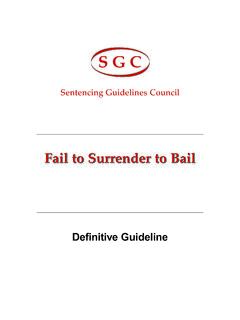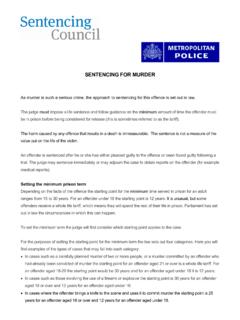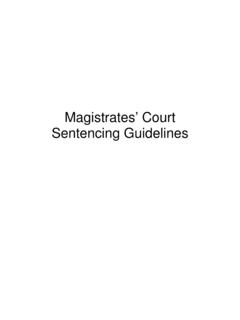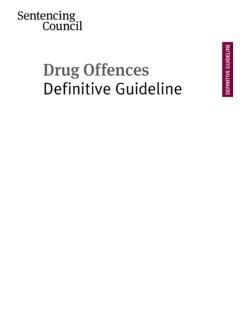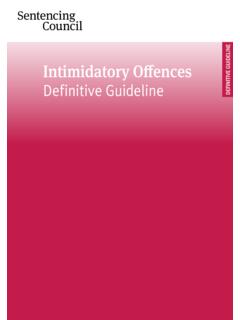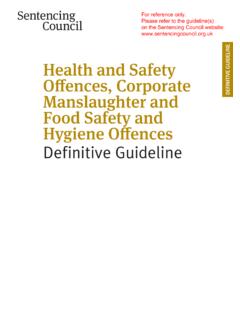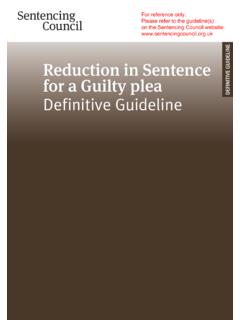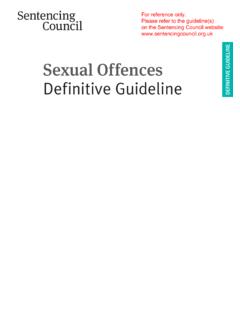Transcription of Dangerous dog offences Definitive Guideline
1 Definitive Guideline Dangerous Dog offences Definitive Guideline Revised - Effective from 1 July 2016 For reference only. Please refer to the Guideline (s) on the Sentencing Council website: ContentsApplicability of GuidelinesDog dangerously out of control in any place where death is causedDangerous Dogs Act 1991 (section 3 (1))Dog dangerously out of control in any place where a person is injuredDangerous Dogs Act 1991 (section 3 (1))Dog dangerously out of control in any place where an assistance dog is injured or killedDangerous Dogs Act 1991 (section 3 (1))Dog dangerously out of control in any placeDangerous Dogs Act 1991 (section 3 (1))Possession of a prohibited dog, breeding, selling, exchanging or advertising a prohibited dog Dangerous Dogs Act 1991 (section 1 (7))Annex.
2 Fine bands and community orders23915212733 Crown copyright 2016 This publication is licensed under the terms of the Open Government Licence except where otherwise stated. To view this licence, visit or write to the Information Policy Team, The National Archives, Kew, London TW9 4DU, or email: Where we have identified any third party copyright information you will need to obtain permission from the copyright holders from 1 July 2016 For reference only. Please refer to the Guideline (s) on the Sentencing Council website: 2 Dangerous Dog offences Definitive GuidelineEffective from 1 July 2016 IIn accordance with section 120 of the Coroners and Justice Act 2009, the Sentencing Council issues this Definitive Guideline . It applies to all offenders aged 18 and older, who are sentenced on or after 1 July 2016, regardless of the date of the offence.
3 Section 125(1) of the Coroners and Justice Act 2009 provides that when sentencing offences committed after 6 April 2010: Every court (a) must, in sentencing an offender, follow any sentencing guidelines which are relevant to the offender s case, and (b) must, in exercising any other function relating to the sentencing of offenders, follow any sentencing guidelines which are relevant to the exercise of the function, unless the court is satisfied that it would be contrary to the interests of justice to do so. This Guideline applies only to offenders aged 18 and older. Structure, ranges and starting points For the purposes of section 125(3)-(4) of the Coroners and Justice Act 2009, the Guideline specifies offence ranges the range of sentences appropriate for each type of offence.
4 Within each offence, the Council has specified a number of categories which reflect varying degrees of seriousness. The offence range is split into category ranges sentences appropriate for each level of seriousness. The Council has also identified a starting point within each category. Starting points define the position within a category range from which to start calculating the provisional sentence. The court should consider further features of the offence or the offender that warrant adjustment of the sentence within the range, including the aggravating and mitigating factors set out at step two. Starting points and ranges apply to all offenders, whether they have pleaded guilty or been convicted after trial. Credit for a guilty plea is taken into consideration only at step four in the decision making process, after the appropriate sentence has been identified.
5 Information on community orders and fine bands is set out in the annex at page 33. Applicability of Guideline For reference only. Please refer to the Guideline (s) on the Sentencing Council website: Dangerous Dog offences Definitive GuidelineEffective from 1 July 2016 3 Owner or person in charge of a dog dangerously out of control in any place in England or Wales (whether or not a public place) where death is caused Dangerous Dogs Act 1991 (section 3 (1)) Triable either way Maximum: 14 years custody Offence range: High level community order 14 years custody Dangerous DOG: DEATH OF PERSON For reference only. Please refer to the Guideline (s) on the Sentencing Council website: Dangerous Dog offences Definitive GuidelineEffective from 1 July 2016 Dangerous DOG: DEATH OF PERSON 4 STEP ONE Determining the offence category In order to determine the category the court should assess culpability and harm.
6 The court should determine the offence category with reference only to the factors in the tables below. The level of culpability is determined by weighing up all the factors of the case. Where there are characteristics present which fall under different levels of culpability, the court should balance these characteristics to reach a fair assessment of the offender s culpability. CULPABILITY demonstrated by one or more of the following: A High culpability Dog used as a weapon or to intimidate people Dog known to be prohibited Dog trained to be aggressive Offender disqualified from owning a dog, or failed to respond to official warnings, or to comply with orders concerning the dog B Medium culpability All other cases where characteristics for categories A or C are not present, and in particular.
7 Failure to respond to warnings or concerns expressed by others about the dog s behaviour Failure to act on prior knowledge of the dog s aggressive behaviour Lack of safety or control measures taken in situations where an incident could reasonably have been foreseen Failure to intervene in the incident (where it would have been reasonable to do so) Ill treatment or failure to ensure welfare needs of the dog (where connected to the offence and where not charged separately) C Lesser culpability Attempts made to regain control of the dog and/or intervene Provocation of the dog without fault of the offender Evidence of safety or control measures having been taken Incident could not have reasonably been foreseen by the offender Momentary lapse of control/attention HARM There is no variation in the level of harm caused, as by definition the harm involved in an offence where a death is caused is always of the utmost seriousness.
8 For reference only. Please refer to the Guideline (s) on the Sentencing Council website: 5 Dangerous DOG: DEATH OF PERSOND angerous Dog offences Definitive GuidelineEffective from 1 July 2016 STEP TWO Starting point and category range Having determined the category at step one, the court should use the corresponding starting point to reach a sentence within the category range below. The starting point applies to all offenders irrespective of plea or previous convictions. High culpability Starting point 8 years custody Category range 6 14 years custody Medium culpability Starting point 4 years custody Category range 2 7 years custody Lesser culpability Starting point 1 year s custody Category range High level community order 2 years custody The table is for single offences .
9 Concurrent sentences reflecting the overall criminality of offending will ordinarily be appropriate where offences arise out of the same incident or facts: please refer to the offences Taken into Consideration and Totality Guideline . The court should then consider any adjustment for any aggravating or mitigating factors. On the next page is a non-exhaustive list of additional factual elements providing the context of the offence and factors relating to the offender. Identify whether any combination of these, or other relevant factors, should result in an upward or downward adjustment from the starting point. See page 6. For reference only. Please refer to the Guideline (s) on the Sentencing Council website: 6 Dangerous DOG: DEATH OF PERSOND angerous Dog offences Definitive GuidelineEffective from 1 July 2016 Factors increasing seriousness Statutory aggravating factors: Previous convictions, having regard to a) the nature of the offence to which the conviction relates and its relevance to the current offence.
10 And b) the time that has elapsed since the conviction Offence committed whilst on bail Offence motivated by, or demonstrating hostility based on any of the following characteristics or presumed characteristics of the victim: religion, race, disability, sexual orientation or transgender identity Other aggravating factors: Victim is a child or otherwise vulnerable because of personal circumstances Location of the offence Sustained or repeated attack Significant ongoing effect on witness(es) to the attack Serious injury caused to others (where not charged separately) Allowing person insufficiently experienced or trained, to be in charge of the dog Lack or loss of control of the dog due to influence of alcohol or drugs Offence committed against those working in the public sector or providing a service to the public Injury to other animals Established evidence of community/wider impact Failure to comply with current court orders (except where taken into account in assessing culpability)
